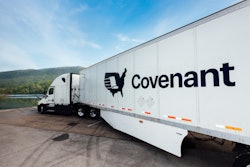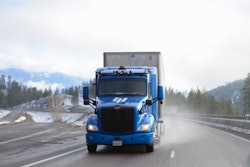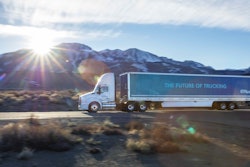Truck drivers do a lot more than simply drive the truck, so autonomous trucks can never be fully driverless until technology is capable of handling all the tasks for which a human driver is responsible. The task list for "the meat in the seat" is lengthy, but among the most critical elements of a professional truck driver's job is the ability to serve as a failsafe when the unexpected arises.
How does a driverless truck handle an emergency, a tire blow out or dash-light indicators warning of imminent failure? Self-driving trucking company Kodiak Robotics on Thursday started chipping away at answering those questions, becoming the first company to publicly demonstrate its fallback system, which autonomously pulls a self-driving truck to the side of the road in the event of a truck or system failure.
The ability to perform a safe, reliable fallback (assuming a minimal risk condition), is critical to safely deploying driverless trucks on public roads, said Kodiak Founder and CEO Don Burnette. There's no shortage of companies running trucks autonomously around the U.S., but in most cases they are equipped with an on-board or remote safety driver. Burnette said Thursday's demo takes another step toward safe driverless automation by removing the driver without sacrificing safety.
"Ten times each second, Kodiak’s self-driving system ingests data from all of its sensors and maps out two different plans for where to drive: a regular plan and a fallback plan," Burnette said. "In case any one of more than 1,000 safety-critical processes and components (including truck-related components like the engine, oil levels and tire pressure and autonomous vehicle system components such as sensors and software processes) ... does not perform as expected, the autonomous system automatically executes the fallback plan, safely pulling to either the left or right side of the road."
Burnette said if flying roadway debris, for example, were to damage one of the autonomous truck’s sensors, the Kodiak Driver would detect the damage and safely pull the truck over. Today, the technology can execute a fallback from the left lane to the left side of the road or from the right lane to the right side of the road. In the future, he said the technology will be able to execute fallbacks across multiple lanes.
Kodiak’s ability to perform safe fallbacks is reliant on the company's own custom-designed safety computer, the Actuation Control Engine (ACE). One of the many crucial functions for which the ACE is responsible is ensuring the autonomous system can guide the truck to a safe stop when necessary while evaluating all the conditions around actually making the maneuver.
"If an autonomous truck needs to execute a fallback plan, it’s not just a matter of the system pulling the truck 20 feet to the right and hitting the brakes," Burnette added. "It’s a fully developed backup plan that is updated constantly, taking into account everything that is happening on the road at any given moment."
The fallback plan must continuously take into account everything that’s happening on the road, avoiding obstacles both in the travel lane and on the shoulder. Burnette said the system ultimately will do whatever is safest, but that outcome changes depending on the circumstances.
"The fallback system will adapt its pullover trajectory based on the fault and the traffic conditions around the truck in the future, which means that a minor fault could make the truck go to the next exit, versus a major fault might make the truck stop right away," he said.
The decision of when and where to execute the fallback also would be influenced by the the roadway itself; how can the truck pull itself to the shoulder when there's not a shoulder, or what if there's a car in the breakdown lane when the truck needs to pull over?
"Because the fallback plan is updated more than 10 times each second, the system will take that into account and create a plan to execute the safest possible option in the event of a fallback," Burnette said. "If the shoulder is not wide enough or does not exist, the truck will pull over as far as it can. Additionally, the truck will avoid obstacles on the shoulder, like parked cars or overhanging trees. If there is no safe way to completely pull the truck to the side of the road – or to the shoulder – it would find and execute another plan, just like a human driver would. The system will update the fallback based on current road and traffic conditions, meaning it will always do whatever is safest depending upon the circumstances."
Kodiak’s ACE safety computer executes a fallback without input from the Kodiak Driver’s main computer. Kodiak’s fourth generation of trucks includes two ACE units for redundancy and additional safety. Should the ACEs lose connection with the Kodiak Driver’s main computer for any reason, from a communications failure to a loose cable, the system will automatically execute a fallback. The ACE is a universal interface to all truck platforms, and Kodiak is currently working to certify the safety computer to the highest automotive-grade standard.












